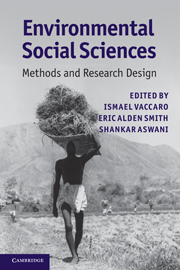Book contents
- Frontmatter
- Contents
- Contributors
- Foreword
- Preface
- 1 Introduction
- 2 People, numbers, and natural resources: demography in environmental research
- 3 Production decisions and time allocation: a guide to data collection
- 4 Analyzing the politics of natural resources: from theories of property rights to institutional analysis and beyond
- 5 Extreme events, tipping points, and vulnerability: methods in the political economy of environment
- 6 Local communities and natural resources: ethnobiology in practice
- 7 Mapping histories: cultural landscapes and walkabout methods
- 8 Metaphors and myths in news reports of an Amazonian “Lost Tribe”: society, environment and literary analysis
- 9 Water decision-makers in a desert city: text analysis and environmental social science
- 10 Linking human and natural systems: social networks, environment, and ecology
- 11 Khat commodity chains in Madagascar: multi-sited ethnography at multiple scales
- 12 Spatiotemporal methodologies in environmental anthropology: geographic information systems, remote sensing, landscape changes, and local knowledge
- 13 Deep time, diachronic change, and the integration of multi-scalar data: archaeological methods for exploring human–environment dynamics
- 14 Comparing trajectories of climate, class, and production: an historical ecology of American yeomen
- 15 Socioecological methods for designing marine conservation programs: a Solomon Islands example
- Index
- References
9 - Water decision-makers in a desert city: text analysis and environmental social science
Published online by Cambridge University Press: 05 June 2012
- Frontmatter
- Contents
- Contributors
- Foreword
- Preface
- 1 Introduction
- 2 People, numbers, and natural resources: demography in environmental research
- 3 Production decisions and time allocation: a guide to data collection
- 4 Analyzing the politics of natural resources: from theories of property rights to institutional analysis and beyond
- 5 Extreme events, tipping points, and vulnerability: methods in the political economy of environment
- 6 Local communities and natural resources: ethnobiology in practice
- 7 Mapping histories: cultural landscapes and walkabout methods
- 8 Metaphors and myths in news reports of an Amazonian “Lost Tribe”: society, environment and literary analysis
- 9 Water decision-makers in a desert city: text analysis and environmental social science
- 10 Linking human and natural systems: social networks, environment, and ecology
- 11 Khat commodity chains in Madagascar: multi-sited ethnography at multiple scales
- 12 Spatiotemporal methodologies in environmental anthropology: geographic information systems, remote sensing, landscape changes, and local knowledge
- 13 Deep time, diachronic change, and the integration of multi-scalar data: archaeological methods for exploring human–environment dynamics
- 14 Comparing trajectories of climate, class, and production: an historical ecology of American yeomen
- 15 Socioecological methods for designing marine conservation programs: a Solomon Islands example
- Index
- References
Summary
Introduction
Text analysis encompasses a broad range of methods. For many researchers, the phrase “text analysis” likely connotes the close reading and interpretation of data that come in the form of words rather than numbers. Yet in this chapter, we argue for an inclusive approach to text analysis – one that recognizes the advantages of moving iteratively between words and numbers in analyzing texts. Our view is that both qualitative and quantitative methods belong in a complete methodological toolkit for analyzing texts. Instead of envisioning text analysis as occupying one side of a qualitative–quantitative continuum, we see text analysis as a suite of methods that can be used to investigate the full range of research questions, from exploratory to confirmatory.
Exploratory research questions are used to understand new phenomena – uncovering how they work and developing new models to describe them. Examples of exploratory research in environmental social science, which we discuss in greater detail below, include Paolisso and Maloney’s (2000) exploration of environmental knowledge of the Chesapeake Bay, and Apostolopoulou and Pantis’ (2009) investigation of failures in Greek conservation policy. Confirmatory research questions are used to test how well existing theories, hypotheses, or models describe a phenomenon of interest. Examples of confirmatory research, also discussed below, include Drieschova, Giordano, and Fischhendler (2008) study of flow variability regulations in international water treaties and Laurian’s (2005) research on the efficacy of citizen input mechanisms in the toxic remediation process.
- Type
- Chapter
- Information
- Environmental Social SciencesMethods and Research Design, pp. 188 - 211Publisher: Cambridge University PressPrint publication year: 2010
References
- 5
- Cited by



